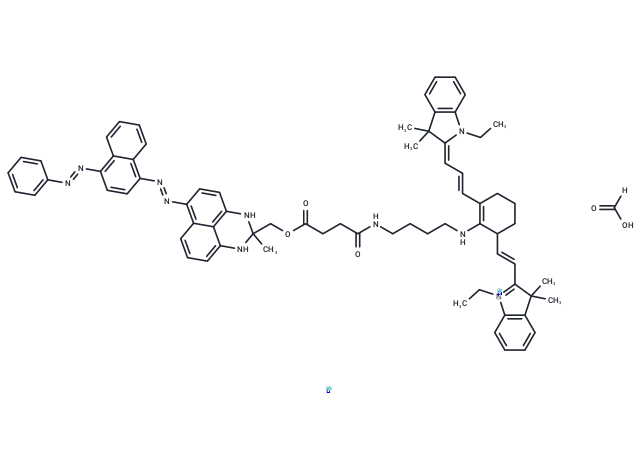Shopping Cart
Remove All Your shopping cart is currently empty
Your shopping cart is currently empty
GLF16 FA is a fluorescent SBB analogue for rapid detection of senescent cells using flow cytometry and live cell sorting.

| Pack Size | Price | USA Warehouse | Global Warehouse | Quantity |
|---|---|---|---|---|
| 1 mg | $997 | In Stock | In Stock | |
| 5 mg | $1,980 | In Stock | In Stock | |
| 10 mg | $2,720 | - | In Stock | |
| 25 mg | $3,990 | - | In Stock | |
| 50 mg | $5,470 | - | In Stock |
| Description | GLF16 FA is a fluorescent SBB analogue for rapid detection of senescent cells using flow cytometry and live cell sorting. |
| Cell Research | Instructions
I. Solution preparation 1. Stock solution: Dissolve GLF16 FA in an appropriate solvent, usually anhydrous DMSO, to prepare a stock solution with a concentration of 1–10 mM. 2. Working solution: Dilute the stock solution to a working concentration, usually 1–5 µM, using an experimental buffer (such as PBS, pH 7.4) or culture medium. II. Operation steps Cell culture experiment (1) Cell type: GLF16 FA can be used to detect senescent cells, especially for a variety of cell lines cultured in vitro. (2) Treatment method: Add GLF16 FA to the cell culture medium and culture the cells for 30 minutes to 1 hour at 37°C, away from light. (3) Cell function detection: a. Senescence marker detection: Detect the fluorescence intensity of GLF16 FA in cells by flow cytometry or live cell sorting to identify senescent cells. b. Cell survival rate detection: CCK-8 or other cell activity detection methods can be used to evaluate cell survival rate. c. Senescence marker detection: Combined with other senescence markers, such as SA-β-gal, the characteristics of senescent cells can be further verified. Animal experiments (1) Treatment method: GLF16 FA is administered to experimental animals by intraperitoneal injection or tail vein injection. The dose is usually 1–10 mg/kg depending on the experimental design. (2) Senescence detection: After injection, the fluorescence signal of senescent cells in vivo is detected by flow cytometry or other imaging techniques. 3. Calibration and control (1) Control group: Set up an untreated cell or animal group as a control to verify the effect of GLF16 FA. (2) Standard curve: Use senescent cell samples with known concentrations to establish a standard curve between the fluorescence signal and the proportion of senescent cells. Notes (1) Storage conditions: GLF16 FA should be stored at -20°C in the dark and avoid repeated freezing and thawing. (2) Fluorescence detection: The excitation wavelength is usually 485–495 nm and the emission wavelength is 515–525 nm. (3) Photosensitivity: GLF16 FA is light-sensitive and strong light exposure should be avoided during the experiment. (4) Solubility: Ensure that GLF16 FA is completely dissolved during dissolution to avoid any solid residue. |
| Molecular Weight | 1305.42 |
| Formula | C73H81IN10O5 |
| Smiles | CC(COC(CCC(NCCCCNC1=C(CCCC1/C=C/C2=[N+](C3=C(C2(C)C)C=CC=C3)CC)/C=C/C=C4N(C5=C(C\4(C)C)C=CC=C5)CC)=O)=O)(NC6=CC=C7)NC8=C6C7=C(/N=N/C9=C%10C(C=CC=C%10)=C(/N=N/C%11=CC=CC=C%11)C=C9)C=C8.[H]C(O)=O.[I-] |
| Relative Density. | no data available |
| Storage | keep away from direct sunlight,store at low temperature | Powder: -20°C for 3 years | In solvent: -80°C for 1 year | Shipping with blue ice/Shipping at ambient temperature. | ||||||||||||||||||||||||||||||
| Solubility Information | H2O: < 1 mg/mL (insoluble) DMSO: 100 mg/mL (76.6 mM), Sonication is recommended. | ||||||||||||||||||||||||||||||
Solution Preparation Table | |||||||||||||||||||||||||||||||
DMSO
| |||||||||||||||||||||||||||||||
| Size | Quantity | Unit Price | Amount | Operation |
|---|

Copyright © 2015-2026 TargetMol Chemicals Inc. All Rights Reserved.